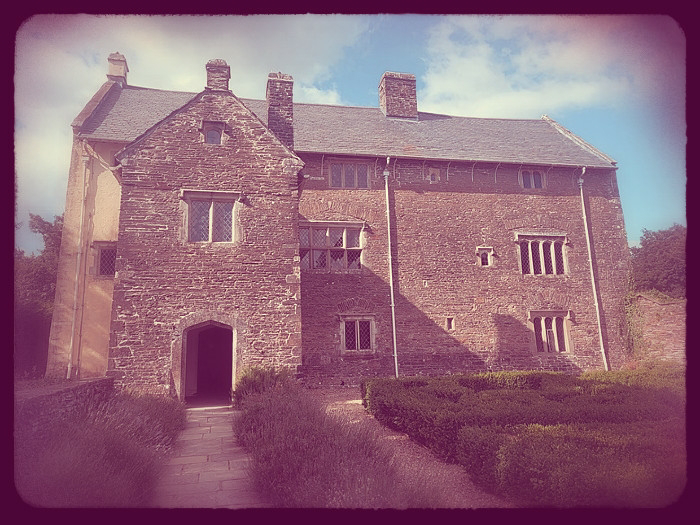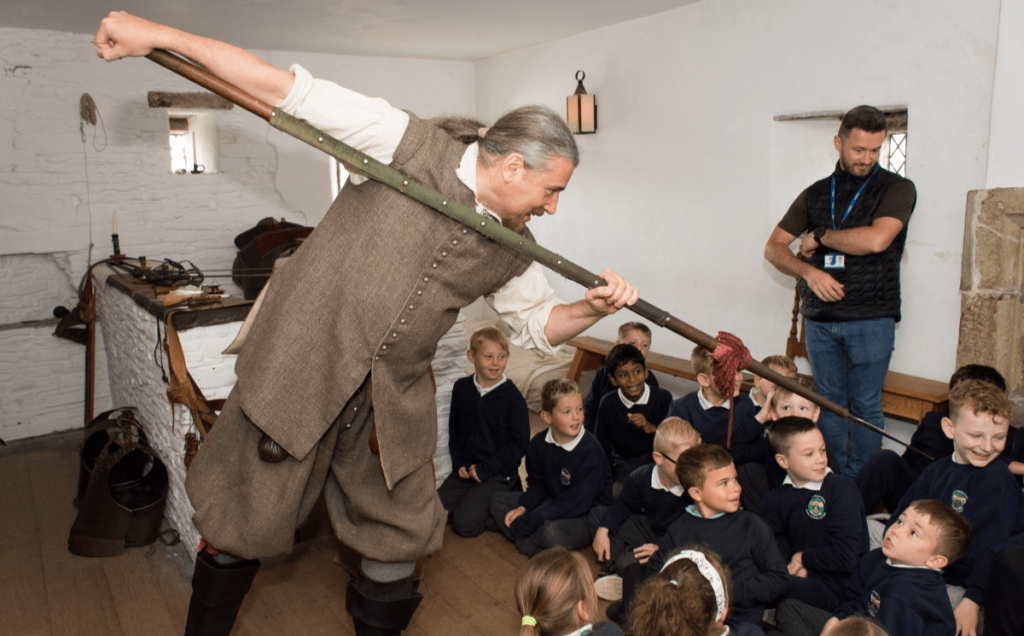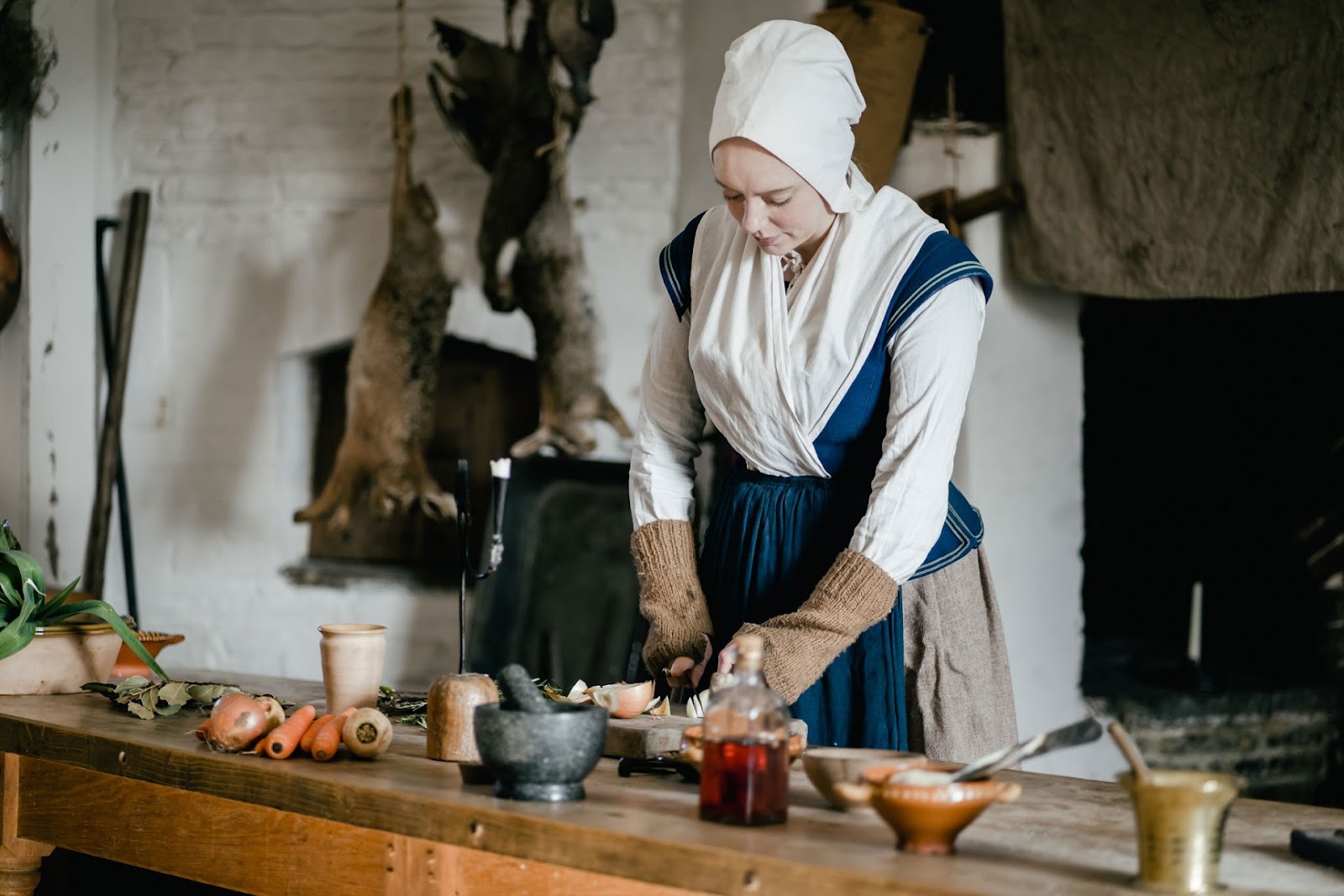Llancaiach Fawr Manor
Llancaiach Fawr Manor is a Tudor manor house that dates back to the 1500s. Located in the town of Treharris, Wales; Llancaiach Fawr Manor is thought to be one of the most important Gentry houses to have survived from the 1500s. The Manor is also thought to be one of the top ten most haunted houses in the UK. The spirits include children, a man in black, plus what is thought to be the spirit of a previous owner who met King Charles the first in this location before fighting against him in the English Civil War.
History
Llancaiach Fawr Manor was thought to have been built during 1530. I've found some sources saying it was built by Dafydd ap Richard, and I've found others saying it was built for Dafydd. As I've found no information on a builder, I can only assume it was built by Dafydd and that he then resided here. While the Time Team conducted excavations here during 2010, they carried out tree ring dating which suggested a felling date of between 1548 and 1565 for the timber used for the roof. This could mean the house was not built until these dates, or it could mean that the roofing timber had to be replaced beyond the locations initial construction.
There is reference of the location within John Leland's Itinerary of 1537, however this could possibly be reference to an earlier house to have existed on the site. It could also have been a reference to a house belonging to the Prichards (ap Richards) in the Parish of Gelligaer. This parish included Dowlais near Merthyr Tydfil; the location this branch of the family came from originally. If it was Llancaiach Fawr Manor which was referenced, and not a house in Dowlais, then that would make the manor potentially older than the Acts of Union between England and Wales which occured during 1537.
The name 'Llancaiach Fawr' has changed greatly over the years since the location's construction. Leland referred to the location as 'Huhkaihac', which was his attempt to transcribe 'Uwch Caiach' which means 'The House above the (river) Caiach'. Edward Prichard's marriage settlement during 1578 mentions 'a capital mansion house' called 'Glankayach'. This is thought to be the next iteration of the name as this means (the house) on the bank of the (river) Caiach. This name was used through the next century, although was usually spelt as 'Glacayach'. During the 1700s the name changed again to 'Llancaeach', and over time it became 'Llancaiach'; the modern spelling.
The land around the manor has historically been used for agricultural purposes. This is seen through medieval ridge and furrow plough marks present in the land. The site has been occupied since the Bronze Age, with the Time Team finding old coins and Bronze Age pottery. Dispite it being speculated about a previous building having stood on the site, the Time Team found no evidence of this during their excavations. It is possible though that any previous iteration may possibly be built into the eastern end of the building, or it may be beneath the present building. Due to the site's Bronze Age connections, it is thought to have been occupied in come capacity for almost 4,000 years. Further adding to the history of the site, there is a huge palisaded enclosure, located in an adjacent field, which has been carbon dated to have been built during 1494 BCE.
As for the present manor, it was built as a highly defensive structure. It's walls are 4' (1.2 metres) thick, and the different floors are accessible through steep stairs which are located within the walls. If the house was under attack, it could be split in two as further protection for the residents. The ground floor windows are very small too. As for why such a defensive house was built, it could be due to a rivalry which occured between the Prichard's which owned the manor, and the Lewis's. They were both branches of the same family, but they had a fierce feud possibly stemming from an incident that occured which involved the murder of a kinsman of Edward Lewis. This murder was apparently done by a servant of Edward Prichard Senior, and this led to the two branches of the family fighting against one another. One fight even occured in the Gelligaer Church.
An extremely important owner of the manor was Colonel Edward Prichard. He was born during roughly 1610, and died during 1655. He was most likely born at the manor, and went on to serve King Charles I for the royalist cause during the English Civil War. During 1642, Edward was named as the Commissioner of Array; meaning he was responsible for raising money and soldiers for the royalist cause across Glamorganshire. On the 5th of August 1645, King Charles visited Llancaiach Fawr Manor in the hopes of gathering Welsh forces for the war. The King's visit was unsuccessful and shortly after Edward, along with other members of the Welsh gentry, switched sides from the royalists to the parliamentarians. Following this switch in sides, Edward had a major role in a a number of battles. He became the Governor of Cardiff Castle, defending it against a siege during 1646, and then fought at the Battle of St Fagans during 1648. Edward did have a family; with his wife being called Mary, and his two daughters being called Mary and Jane.
Changes were made to the manor during the 1600s. A grand staircase was added, two rooms were panelled, several of the intramural staircases were sealed off, and a formal garden was laid out. All of this occured during 1628, and as the years passed more of the staircases and passageways within the manor were sealed off. This has led to there being more windows on the outside of the house than what can be seen from the inside. The Prichards and their servant's lived in the manor until 1660, and very little is known of the time after this point. The Prichards were the sixth wealthiest family in Glamorgan, and the manor eventually became a working farm. Due to this change in purpose, the original garden does not remain.
The manor became a tenanted farm house until 1979 when it was bought by the Rhymney Valley District Council. Following this purchase, the manor underwent restoration during the 1980s, and then the Living History Museum which the manor is used for today opened during 1991. As a living history museum, most of the furniture and furnishings are replicas based on the originals which can be seen at the Museum of Welsh Life at St Fagans near Cardiff. The Living History Museum also has actors to fully immerse visitors within the time period of King Charles' visit of 1645. This way, visitors can learn about the history through experiencing it.
Llancaiach Fawr Manor is one of the last original semi-fortified manors in Wales, and it is grade I listed. The wooden panelling within the manor has been preserved from 1628, which adds to the real history which can be experienced within the building. The council has tried to recreate the original gardens according to outlines and pollen grains. They've also added certain elements which could be found in any garden from the 1600s and 1700s. The restoration and development of Llancaiach Fawr Manor was all possible due to the 'Friends of Llancaiach' who raised funds and physically helped out alongside the staff of the location. An orchard, physic, privy and vegetable gardens were also developed in their original layout at the front of the manor.
The manor has been voted as the Best Family Attraction in Wales, and during 2015 it hosted the Urdd Eisteddfod. This event brought over 88,500 people to the location. The manor has also been used as a filming location for Doctor Who for episodes 'The Vampires of Venice' (2010) and 'The Witchfinders' (2018). The location also hosts ghosts tours through October, November, and December. These tours last for roughly one hour and thirty minutes, and cost roughly £18.50 per person.
Hauntings
The most prominent haunting in Llancaiach Fawr Manor is that of a housekeeper from the 1800s called Mattie. She is thought to have lived in the manor during the late 1700s and early 1800s, and died there when burned in an accident. She can be seen and heard within the bedroom where she died, and she fills the bedroom with grief, sadness, and anguish. A South-African under-21s rugby team visited the location, and the captain of the team broke down in tears for no reason while in Mattie's room. The captain was fine again upon leaving the room, but did feel embarrassed by what had happened. Mattie is also said to stare out of the bedroom window, plus her dress can sometimes be heard rustling. It's been said that Mattie wears a white blouse.
A small boy has been seen and felt in the upper chamber where he died by falling from one of the windows during 1906. This boy is thought to tug on the sleeves, hair, and dresses of visitors. He's also thought to be the spirit that causes the sensation of your hand being held by something unseen. A second child is also thought to be present. I've found that a hooded girl is thought to haunt the location, but with no information about their age, it's unsure if this hooded girl is the second child. Child's laughter can be heard through the building and a cradle rocks on its own in one of the bedrooms.
A man who appears to be in deep thought has been seen in the building. This man is suspected to be Colonel Edward Prichard; possibly thinking over if he should switch allegiances in the English Civil War. A man wearing a war uniform has been seen, and this is also thought to be Edward Prichard. I've found no accounts on if these two Edward suspects are both wearing a uniform, so they could potentially be seperate spirits. I've found that a soldier is said to wander the grounds, and I feel this is likely the man in the war uniform.
Usually locations are host to a lady in white or black, but instead this location has a man in black that potentially haunts it. This man is presumed to be a murderer and stalks tour groups. He also patrols the parameter of the house. In the Great Hall, which used to be a court, a figure of a man has been seen staring out of the window. This ghost could also be the previously discussed Edward Prichard ghost. A murder victim is said to roam the grounds along with a man in a victorian outfit. The victorian man was seen by Ed Williams, who lived within the manor during his childhood before it was sold to be used as a museum. Ed saw the victorian man rush past him, and he heard four loud and distinct footsteps from upstairs. As a teenager, Ed made a ouija board and experienced the glass fly across the room and smash.
Odd smells have been experienced withing this location too such as the unexplained smell of violet, lavender, and roast beef. Footsteps have been heard on the upper floor and stairs, doors slam on their own, and the sound of keys jangling in the corridors has been reported. There is also speculation around if the manor has been cursed due to a carved stone which is located within the manor wall. This stone has witch marks etched on it, similar to what exists within the cell doors at Derby Gaol. These marks are thought to either ward off evil, or to place a curse on the location. Due to the fortified nature of the location, I would assume the purpose as being to ward off evil; but it does raise interesting speculation as to how long the location has been thought of as haunted for.
Summary Of Hauntings
1. Mattie, 1800s housekeeper, died in fire, dress rustles, fills room with sorrow - bedroom
2. Colonel Edward Prichard, war uniform
3. Small boy, fell from window during 1906, holds hand, tugs hair and clothes - upper chamber
4. Man in deep thought, Edward Prichard?
5. Man looking out of window, Edward Prichard?
6. Hooded girl, second child?
7. Man in black, presumed murderer - follows groups, perimeter of house
8. Murder victim
9. Man in victorian outfit
10. Violet scent
11. Lavender scent
12. Roast beef scent
13. Footsteps - stairs, upper floor
14. Cradle rocks in one bedroom
15. Ouija board glass flew across a room and smashed
16. Children's laughter
17. Keys jangling
18. Doors slam
My Thoughts
I feel like, although there are eighteen points listed above in the summary, the location's reputation potentially exceeds it's actual activity. Three of the reported males to haunt the location could all the one spirit of Edward Prichard. I would assume the soldier who wanders the ground to be the same as both he and Edward are reported to wear a soldier's uniform. There may be differing time periods to the two soldiers, but there isn't enough information to know for sure. That's a good way of summarising this location: there isn't enough information. There are huge chunks of time missing from my sources, with all of them fixating on the civil war time period. This implies to me that very little happened during the rest of the manor's history, and so it doesn't boast the turmoil often associated with heightened paranormal activity.
I do, however, suspect this location could be promising to experience hauntings while it is operational as a living museum. There is a theory about the paranormal called Singapore Theory which suspects haunting activity to increase upon enhanced replication of a prior time period. It's similar to how dementia patients may be more responsive when listening to music from their past. Putting the spirits into the time periods they're from potentially increases the energy they have, or the will they have, to interact with the world around them; and so haunting activity increases. As a result, I feel Llancaiach Fawr Manor is an important case study for paranormal locations as it potentially provides good testimony for Singapore Theory. The location being kept as it was during the royal visit, plus actors actively living in that time period, could very well lend to the locations haunted reputation.
The living museum does provide a downside though, as do the ghost tours. The location clearly wants to capitalise on hauntings and history; so this could lend to certain instances, stories, or experiences, being faked or ingenuine in some way. To make additional profit from ghost tours, the location needs a reputation for being haunted. They have costumes too, so it would be easy for one of the actors to pretend to be a ghost for a short while. This is all speculation though, and is something to keep in mind when locations profit from their hauntings; especially when costumes and actors are involved in the location's day to day running.
Thank You!
Thank you for reading to the end of this post! It was interesting to write about a location where Singapore Theory is being applied each day of it's operation. It was also odd to see how patchy this location's history is in comparison to other locations. I do think some good activity could be captured here, but with so little known about the spirits and the hauntings; it is a location where you can't help but question the validity of it's activity.
A special thank you goes to Damain, Nicolette, Kerry, GD, The Cornish Ghost Whisperers, Beardo Gets Scared, Starlight Phoenix Paranormal, Paranormal Penny Pinchers, the Australian Paranormal Society, Codegas Codex of Curiousity, Phantom Detectives LLC, and Shadow Walkers Paranormal Investigators for your continued support of The True Paranormal. If you want to follow The True Paranormal you can do so on Facebook, Tik Tok, Instagram, X (formerly known as Twitter), and Tumblr. You can also subscribe to The True Paranormal on YouTube, or directly to this website through the bar on the left which will give you email notifications. That bar also lists all of the links which will take you to The True Paranormal's various social media platforms. If you want to contact me about your own experiences, or about anything at all paranormal, you can email thetrueparanormal1@gmail.com
A Donations Message
At the moment I don't have any ads running on anything, and I intend on the blog always being free for everyone to view because I believe knowledge should never be kept behind a paywall. I do, however, still need an income in order to continue writing articles. If you would like to donate towards The True Paranormal, you can do so via PayPal. If you are interested, my username is Daniel Carr and my paypal email is danielcarr130913@gmail.com. If you donate, I will be sure to thank you across social media and in my articles. Anything donated is much appreciated.
Sources I Have Used
2. Visit Wales
8. Spirit Shack
11. Wales Online
12. Haunted Rooms
16. Visit Caerphilly
17. Higgypop
18. North Wales Live
19. Land Of Legends
24. YUMPU
25. Securahome
26. Twinkl
27. Daffadillies
28. Flickr
31. BBC News
33. Tours Of Wales
35. Haunted Houses
36. Flickr: Haunted
37. FQ Magazine
43. Nation.Cymru












Another very interesting and thought provoking article. I would be very interested in your view as to why spirits appear to do the same thing over and over again ie sit in a thinking pose. Does this mean they are doing action replays for example? GD
ReplyDelete